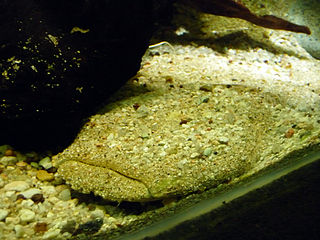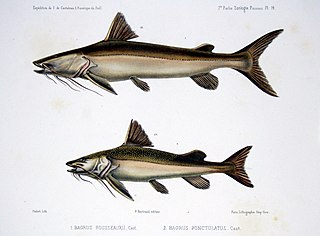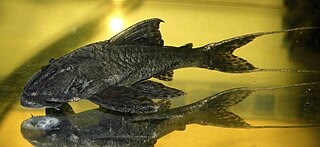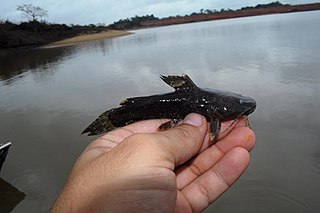
Hypostomus is a genus of catfish in the family Loricariidae. They are native to tropical and subtropical South America. H. plecostomus is the popular freshwater aquarium fish formerly known as Plecostomus plecostomus. There is a lot of confusion as to the precise taxonomic structure of the Loricariidae.

Corydoras is a genus of freshwater catfish in the family Callichthyidae and subfamily Corydoradinae. The species usually have more restricted areas of endemism than other callichthyids, but the area of distribution of the entire genus almost equals the area of distribution of the family, except for Panama where Corydoras is not present. Corydoras species are distributed in South America where they can be found from the east of the Andes to the Atlantic coast, from Trinidad to the Río de la Plata drainage in northern Argentina. Species assigned to Corydoras display a broad diversity of body shapes and coloration. Corydoras are small fish, ranging from 2.5 to 12 cm in SL., and are protected from predators by their body armor and by their sharp, typically venomous spines.

The Amblycipitidae are a family of catfishes, commonly known as torrent catfishes. It includes three genera, Amblyceps, Liobagrus, and Xiurenbagrus, and about 36 species.

Pseudoplatystoma is a genus of several South American catfish species of family Pimelodidae. The species are known by a number of different common names. They typically inhabit major rivers where they prefer the main channels and tend to stay at maximum depth, but some species can also be seen in lakes, flooded forests, and other freshwater habitats. They have robust bodies, and are important food fish. Recently, their population size has been on the drastic decline due to a variety of factors including overfishing and habitat destruction due to the construction of hydroelectric dams.

The Doradidae are a family of catfishes also known as thorny catfishes, raphael catfishes or talking catfishes. These fish are native to South America, primarily the Amazon basin and the Guianas.

The Cetopsidae are a small family of catfishes, commonly called the whale catfishes.

The Aspredinidae are a small South American family of catfishes also known as the banjo catfishes, with about 43 species.

Trichomycterus is a genus of fish in the family Trichomycteridae, the largest genus of its family with over 170 species currently described. This genus is native to freshwater habitats in Central and South America. These fish are generally small, usually about 5 to 15 cm (2–6 in) in standard length, although the largest, T. rivulatus, can reach more than twice this size. Species differ from one another primarily in body proportions, fin ray counts and colouration. Despite their relatively small size, some, such as T. punctulatus, support fisheries and are important in the local cuisine.

The Pseudopimelodidae are a small family of catfishes known as the bumblebee catfishes or dwarf marbled catfishes. Some of these fish are popular aquarium fish.

Brachyplatystoma is a genus of catfish from the family Pimelodidae. As the occasionally used common name goliath catfishes indicates, this genus includes some of the largest species of catfish, including the piraíba, B. filamentosum, which reaches up to the region of 3.6 metres (12 ft) in length. Brachyplatystoma are found in the Amazon and Orinoco basins, and other tropical freshwater and brackish habitats in South America. Some species are migratory. These fish are important as food fish and, to some extent, aquarium fish.

Hemiancistrus is a genus of suckermouth armored catfishes. These species are native to South America. The taxonomy of this genus is complex and unclear, and major work has to be done. Many of these fish are popular aquarium fish.

Hemibagrus wyckioides, the Asian redtail catfish, is a species of catfish of the family Bagridae.video

Batrochoglanis is a small genus of catfishes of the family Pseudopimelodidae.
Zungaropsis is a genus of catfish of the family Pimelodidae. It is a monotypic genus, containing only the single species Zungaropsis multimaculatus, and is considered closely related to Zungaro. In 2003, Zungaropsis was considered as a genus inquirendum of the Pimelodidae.
Pareiorhina is a genus of armored catfishes native to South America where they are only found in Brazil. These species are known to occur at altitudes above 650 metres (2100 ft) in various rivers of the Grande, Paraíba do Sul, São Francisco and Tietê River basins. This genus was first erected by Gosline in 1947 as a monotypic genus to include Rhinelepis rudolphi. It was not until 2003 that a second species, P. carrancas, was described. The third species, P. brachyrhyncha was described in 2005. Pareiorhina forms a monophyletic subunit with Neoplecostomus within the subfamily Neoplecostominae.

Helogenes is a genus of whale catfish found in tropical South America.

Bagarius is an Asian genus of catfishes of the family Sisoridae. It includes five to six extant species and potentially one extinct fossil species, B. gigas.

Cetopsis is a genus of catfishes of the family Cetopsidae.

Synodontis nigrita, known as the false upside down catfish, is a species of upside-down catfish that occurs widely in northern Africa. It was first described by French zoologist Achille Valenciennes in 1840. The type specimen is in the Muséum National d' Histoire Naturelle de Paris.

Entomocorus is a genus of catfishes of the family Auchenipteridae.
















